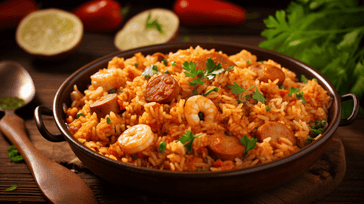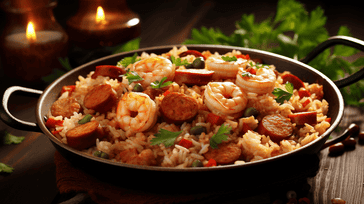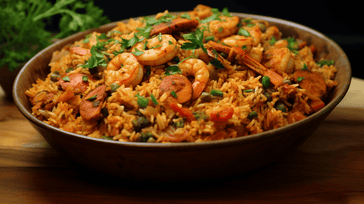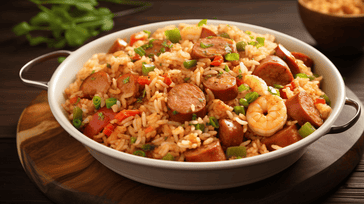- 23 November, 2025
- 56,597 Views

Welcome to a world of comfort food and rich flavors with jambalaya at the center of it all. This classic Southern dish has been a favorite for generations, and for good reason. Jambalaya is easy to make, versatile, and downright delicious. In this article, we'll share some of the best jambalaya recipes from Louisiana and beyond, as well as tips and tricks for perfecting this iconic dish.
Whether you're a seasoned pro or just starting out in the kitchen, we've got something for you. From easy jambalaya recipes to authentic and traditional versions, we've got your cravings covered. So, get ready to savor the best jambalaya recipes and experience the magic of Southern cooking made simple. Let's get started!
What is Jambalaya?
Jambalaya is a beloved dish that originated in Louisiana. It is a one-pot meal that combines rice, vegetables, and meat or seafood. The name "jambalaya" is believed to come from the French word "jambon," which means ham, and "aya," which is likely derived from the West African term for rice, "ya."
There are two main types of jambalaya: Creole and Cajun. Creole jambalaya is made with tomatoes, while Cajun jambalaya is made without them. Both versions include the "holy trinity" of Cajun and Creole cooking: onions, bell peppers, and celery. These vegetables are sautéed with meat or seafood and then combined with rice and stock to make a flavorful one-pot dish.
Jambalaya is known for its bold flavors and spicy kick. The dish can be made with a variety of meats, including chicken, sausage, and shrimp, and is often seasoned with cayenne pepper, paprika, and thyme.
Easy Jambalaya Recipe

For those who are new to jambalaya, this easy-to-follow recipe will introduce you to this scrumptious Southern dish. With a few simple ingredients and a little patience, you can enjoy a flavorful meal that will transport you to the heart of Louisiana.
| Ingredients: | Amount: |
|---|---|
| Andouille sausage | 1 pound, sliced |
| Boneless, skinless chicken thighs | 1 pound, cubed |
| Green bell pepper | 1, chopped |
| Onion | 1, chopped |
| Celery | 2 stalks, chopped |
| Garlic | 3 cloves, minced |
| Diced tomatoes | 1 can (14.5 ounces) |
| Chicken broth | 3 cups |
| Long grain white rice | 2 cups, uncooked |
| Cajun seasoning | 2 tablespoons |
Instructions:
- Heat a large pot or Dutch oven over medium-high heat. Add the sliced Andouille sausage and cook until browned, about 5 minutes. Remove the sausage from the pot and set aside.
- Add the cubed chicken to the pot and cook until browned, about 5 minutes. Remove the chicken from the pot and set aside.
- Add the chopped bell pepper, onion, celery, and minced garlic to the pot. Cook until the vegetables are softened, about 5 minutes.
- Add the diced tomatoes (with juice), chicken broth, uncooked rice, and Cajun seasoning to the pot. Stir well to combine.
- Add the cooked sausage and chicken back to the pot. Stir well to combine.
- Bring the mixture to a boil, then reduce heat to low and cover. Simmer for 25-30 minutes, or until the rice is cooked and the liquid has been absorbed.
- Remove from heat and let stand for 5-10 minutes before serving.
Enjoy your delicious homemade jambalaya with some crusty bread and a side salad for a complete meal.
Note: For an extra kick of heat, add a pinch of cayenne pepper or hot sauce to the pot before simmering.Authentic Jambalaya Recipe
For those looking to experience the true taste of Southern cooking, an authentic jambalaya recipe is a must-try. This savory dish is a staple in Louisiana and has been perfected over generations. Here’s how to make it:
| Ingredients: |
|
|---|---|
| Instructions: |
|
This recipe serves 6-8 people and can be adjusted to taste. Some variations may include adding shrimp or using different types of sausage. Regardless of variations, an authentic jambalaya recipe always includes the holy trinity of Cajun and Creole cuisine: onions, bell peppers, and celery. Serve hot and enjoy the authentic flavors of this classic Southern dish.
Homemade Jambalaya Variations

One of the great things about jambalaya is that it can be customized to suit your taste buds. Here are some variations that you can try:
| Variation | Ingredients |
|---|---|
| Seafood Jambalaya | shrimp, crab, oysters, scallops, fish (optional) |
| Vegetarian Jambalaya | eggplant, zucchini, yellow squash, bell peppers, onions, tomatoes, celery, garlic |
| Chicken and Sausage Jambalaya | chicken thighs, andouille sausage, onions, green bell peppers, celery, garlic, tomatoes |
You can also experiment with the spices and seasonings to make your jambalaya unique. Try adding smoked paprika, cayenne pepper, or hot sauce for a spicy kick. If you prefer a milder flavor, use less of these spices or omit them altogether.
Tip: Don't be afraid to experiment with different combinations of ingredients. Jambalaya is a forgiving dish that can accommodate a variety of flavors.
Tips for Perfecting Jambalaya
Jambalaya is a dish that requires precision and attention to detail. Here are some tips for making sure your jambalaya turns out perfect every time:
- Season, season, season: Jambalaya is all about layers of flavor, so don't be afraid to use bold spices and seasonings. The combination of cumin, paprika, and cayenne pepper are essential to creating that classic Southern taste.
- Properly cook the rice: The rice is a crucial element of jambalaya, and it needs to be cooked just right to achieve the perfect texture. Be sure to use the correct amount of liquid and follow the cooking instructions closely.
- Balance the ingredients: It's important to achieve the perfect balance of meats, veggies, and rice. Aim for a ratio of around 50% rice, 25% meat, and 25% vegetables. This will ensure that each bite has the perfect combination of flavors and textures.
- Let it rest: Once the jambalaya is finished cooking, allow it to rest for a few minutes before serving. This will give the flavors a chance to meld together and allow the rice to fully absorb the sauce.
- Experiment with different meats: While chicken, sausage, and shrimp are the most traditional meats used in jambalaya, don't be afraid to branch out and try different options. Andouille sausage, duck, and even alligator have all been used in authentic jambalaya recipes.
The History of Jambalaya

Jambalaya is a beloved dish in Southern cuisine, particularly in Louisiana. Its history is deeply rooted in the food traditions of the region.
The origins of jambalaya can be traced back to Spanish and French settlers in Louisiana who adapted their paella and jambon dishes to include local ingredients such as rice, onions, bell peppers, celery, and pork. Over time, the dish evolved to include a wider range of proteins and seasonings.
Jambalaya became a popular food in the late 19th and early 20th centuries, particularly among African American communities in Louisiana. It was a staple at social gatherings and celebrations such as Mardi Gras.
"Jambalaya is as much a staple in New Orleans as red beans and rice."
Today, jambalaya remains an important part of Louisiana's food culture and is enjoyed by people all over the world. Its history reflects the diverse influences that have shaped Southern cuisine, making it a truly unique and flavorful experience.
Jambalaya in Southern Cuisine
Jambalaya has long been a staple dish in Southern cuisine, particularly in Louisiana. Its hearty and flavorful nature makes it a popular choice for family gatherings, celebrations, and even everyday meals.
While jambalaya can be traced back to West African, French, and Spanish culinary influences, it has become a beloved icon of Southern cooking. The dish has even inspired festivals and competitions throughout the region, highlighting its cultural significance.
The Importance of Authentic Jambalaya
For many Southerners, the best jambalaya is one that stays true to its roots. Authentic jambalaya is often made with a combination of meats such as chicken, sausage, and shrimp, and seasoned with a mix of herbs and spices. The dish typically includes the “holy trinity” of Southern cooking – onions, bell peppers, and celery – for added flavor.
While there are many variations and adaptations of jambalaya, sticking to authentic ingredients and cooking techniques can help to ensure the dish retains its traditional taste and appeal.
Whether enjoyed at home or in a Southern restaurant, jambalaya continues to hold a special place in the hearts and palates of those who love Southern cuisine.
Serving and Pairing Jambalaya
One of the great things about jambalaya is its versatility when it comes to serving and pairing. Here are some suggestions to elevate your jambalaya experience:
Serving Ideas
When serving jambalaya, it's best to let the dish take center stage. Consider keeping sides simple and complementary.
| Side Dish | Description |
|---|---|
| Cornbread | The slightly sweet flavor and texture of cornbread is a classic pairing for jambalaya. |
| Coleslaw | A cool, tangy coleslaw provides a refreshing contrast to the spicy and hearty jambalaya. |
| Okra | Okra, a classic Southern vegetable, is another excellent complement to jambalaya. Try it sautéed or lightly fried. |
Pairing Ideas
When it comes to pairing beverages with jambalaya, consider a drink that will refresh your palate and balance the heat.
- Beer: A cold beer, particularly a lager or pilsner, pairs well with the spicy flavors of jambalaya.
- Wine: A light red or white wine, such as a Pinot Noir or Sauvignon Blanc, complements the complexity of the dish.
- Cocktail: Try a classic Hurricane cocktail or Margarita to add some tropical flair to your jambalaya meal.
Whatever you choose, make sure it's something you enjoy and that will enhance the overall dining experience.
Jambalaya Recipe Variations from Around the World
While jambalaya is considered a quintessential Southern dish, it has also found its way into various international cuisines, each with their unique twist on the classic recipe. Here are three jambalaya variations from around the world to try:
Spanish Paella
Paella is a Spanish rice dish that shares many similarities with jambalaya. It usually includes saffron, bell peppers, tomatoes, and seafood such as shrimp and mussels. The main difference is that paella is typically made with short-grain rice while jambalaya uses long-grain rice. To make this dish, you can substitute the jambalaya spices with saffron and smoked paprika.
Cajun Jambalaya
While jambalaya is often associated with Creole cooking, there is another jambalaya variation from Louisiana known as Cajun jambalaya. This version typically uses fewer ingredients and has a spicier profile than Creole jambalaya. It is usually made with Andouille sausage, chicken, and shrimp, and often includes a variety of peppers. To make this dish, substitute the Creole spices with Cajun seasoning.
Caribbean Jambalaya
In the Caribbean, jambalaya is often made with a mixture of meats such as chicken, shrimp, and chorizo, along with tropical fruits such as pineapple and mango. The rice is typically cooked in coconut milk, which gives it a creamy texture and a hint of sweetness. To make this dish, you can add coconut milk and fruits to your jambalaya recipe, along with some Caribbean spices such as allspice and nutmeg.
Trying out different jambalaya variations from around the world is a great way to expand your culinary horizons and explore new flavor combinations. Whether you're a fan of seafood, meat, or vegetables, there is a jambalaya variation out there that is sure to satisfy your taste buds.
FAQ About Jambalaya
Are you curious about jambalaya? Here are some frequently asked questions and answers to help you get started:
What is the origin of jambalaya?
Jambalaya is a dish with roots in the Louisiana Creole and Cajun cuisine. Its name is derived from the Spanish word, “jambalaya,” which means a mish-mash or mix-up of ingredients.
What is the difference between Creole jambalaya and Cajun jambalaya?
Creole jambalaya typically contains tomatoes, seafood, and a variety of meats, while Cajun jambalaya is brown and only contains meat and sausage.
Can I make jambalaya ahead of time?
Jambalaya can be made ahead of time and reheated, but it is best when served fresh.
What type of rice should I use for jambalaya?
Long-grain rice is the traditional rice used for jambalaya. However, you can use any type of rice you prefer.
What protein can I use in jambalaya?
Common proteins used in jambalaya include chicken, sausage, shrimp, and crawfish. However, you can use any protein you prefer.
Can I make a vegetarian version of jambalaya?
Yes, you can make a vegetarian version of jambalaya by using vegetable broth and substituting the meat with vegetables such as mushrooms, bell peppers, and okra.
How do I know when the jambalaya is ready?
The jambalaya is ready when the rice is fully cooked and has absorbed all the liquid. The meat should be tender and fully cooked as well.
What is the best way to store leftover jambalaya?
Leftover jambalaya should be stored in an airtight container in the refrigerator. It can be kept for 3-4 days and reheated in the microwave or on the stovetop.
With these answers to common questions about jambalaya, you’ll be ready to make this Southern classic with ease!
